

Christer Dynna
Marit Tingleff makes large earthenware dishes that won’t fit on a dining table. In this interview she relates this format to the porcelain and fine china that was once part of a broad culture and tradition carried mainly by women, and which has since been relegated to flea markets or – at best – the kitchen cupboard.
Marit Tingleff makes ceramics in the format of supersized slab forms measuring up to two and a half metres. A recent group exhibition called Forces,1 which she shared with two other artists of her generation, was a good opportunity to review the dialogue she has been conducting with this format since the late 1980s.
Super large pieces have become her signature in some ways, but this work is about more than mere technical prowess and the boldness of proportions. Another crucial aspect is her desire to throw into relief an untold story of a culture that has been carried mostly by women.
‘I address this in my own way, in terms of the rituals and culture of serving and sharing meals, which entail the use of china and pottery – objects with a rich culture that speak of the lives people lived. I want to tell their story too, in homage to all serving dishes. I also want to honour all those hands that have carried such dishes to the table, and the same – often female – hands that have had to wash them up and put them away.’
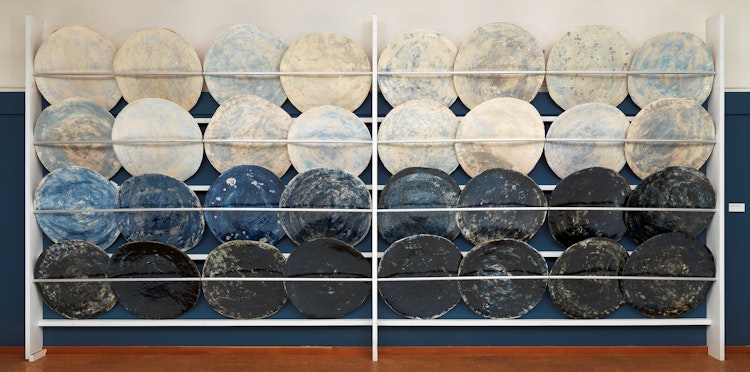
Meals apart
Apart from untold stories about anonymous hands behind a wider culture of shared meals, whether of the everyday kind or the more ritualised Sunday dinners – the stories in Tingleff’s art also contain a personal note.
‘One aspect of this culture of hospitality is the particular relationship women could have with their crockery, since one usually had to save up in order to buy tableware. Pieces of china were precious things, and very dear to people,’ says Tingleff.
When we see such items en masse on flea markets or in thrift stores, it becomes difficult to recognise the value they once had and which Tingleff and others are eager to acknowledge. Tingleff admits that she has transferred her own Sunday china to the kitchen cupboards so as to have it within reach for everyday meals rather than keeping it reserved for special occasions.
‘I still remember the dinners served by my grandmother on her china as very important. Today’s younger generation may not even understand what this was all about,’ she says, stressing that this is not necessarily meant as a critique, since the young people of today must have their own version of culture and hospitality.
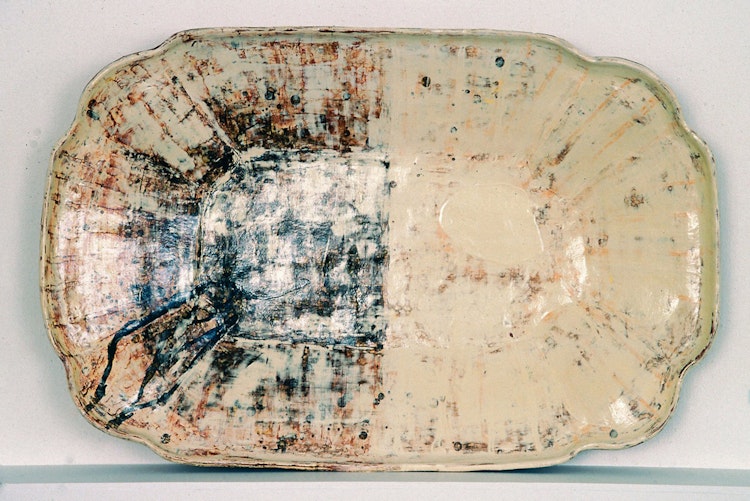
The French art historian Frédéric Bodet, who curated the Paris edition of the show Tingleff shares with her fellow artists Kari Dyrdal (textiles) and Torbjørn Kvasbø (ceramics), points to Tingleff’s concern with questions of female identity and women’s place in the arts. In the exhibition catalogue, he observes that, since her debut, Tingleff has always ‘managed to introduce a fair share of feminine subjectivity, openly pursued as a form of “identity commitment”’.
While doing his research for the exhibition by the trio, which opened in France’s National Museum of Ceramics in the spring of 2018, Bodet noted Tingleff’s ability to modify her commitment ‘with a certain irony’: ‘Marit Tingleff plays with all that is still too often scornfully considered as “feminine” in art. She subtly studies the criticisms habitually aimed at female artists, namely their obsessive meticulousness, their excessive taste for adornment and their overly psychological approach.’
Unassuming and terrific
Raising our awareness of the work women do in the kitchen and their invisible hands is just one part of the challenge Tingleff has set herself. Early on, while still finding her feet as an independent ceramicist she consciously chose not to use any of the many available imported clays. Instead she chose a standard Norwegian clay, known simply as “red clay”, as her preferred material. This had served Norwegian potters for generations as the only reasonably priced clay available to them. After the Second World War the situation changed, as stoneware clays and other imported materials began to find favour with ceramicists eager to exploit new possibilities that would draw crowds. Tingleff admits that by turning to local history she was seeking to redress an ignorance about her predecessors. Both for herself and others, this lack of knowledge gave a degree of freedom to work without having to think of history with a capital H, since there was no canon of local pottery. The basic Norwegian clay has qualities that Tingleff still finds advantageous today.
‘I got my clay from South Norway. It has a plasticity that makes it wonderful to model and to work with when wet. But it also has a strong “will” of its own, its own force. And building a flat surface that holds that shape when fired is difficult. A circular form is more able to support the forces within the clay than my flat slabs.’
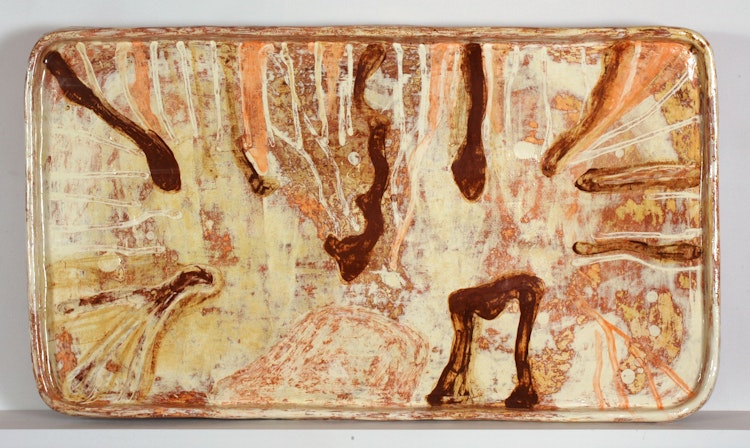
Sport mentality
Challenging conventions – and herself – is a driving force in Tingleff’s steady experimentation with clay and slips. Searching for the limits of her materials, testing what is possible, is key to her orientation. And having once moved beyond the realm of utility ware, it was only the physical limits that could hold her back.
‘Once the object is no longer supposed to be used, I thought there was no need even to relate to the table. The first big dishes I made were near impossible, although they measured no more than 90 centimetres at their widest. Yet this was a bit of a “sport’s challenge” – to achieve something that seemed at first sheer impossible.’
The process of decorating these large objects then became a matter of handling square meters rather than square centimetres. For Tingleff, however, this was perhaps her ultimate goal – since these large pieces presented an extraordinary surface for some serious decorative work. Here she could use her whole arm rather than just the wrist, as one does when making conventional utility ware. Such monumental surfaces were an excellent opportunity to explore her passion for slips and engobes. These are watery slurries of clay that are used to achieve colour. They are applied wet using a brush or sponge, or simply by pouring from a cup or the hands. Tingleff speaks enthusiastically about the simplicity of slips, a technique which, she says, entails very little of the chemistry involved in various other kinds of artistic process.
Marit Tingleff in the ceramic departement at the Oslo National Academy of the Arts, 2018. Photo: Christer Dynna.
Larger than ever
The largest slabs forms she has made so far date from 2017. These were a series of four trough forms. Each uses some 350 kilograms of clay. For this project she imported her materials from Germany, where they could prepare and pack it in ways more suitable to her purpose. Each piece when fired measures two and a half metres by 130 centimetres.
As they were drying, prior to firing, the troughs developed webs of cracks. These she filled with coloured epoxy resin, turning them into webs of monochrome glues that bear witness to the forces involved in the production process. In order to enlist the help of gravity when applying slips, Tingleff resorted to the use of a hydraulic lifting-device as part of a process in which she would normally only use her own muscle power. The ability to let the slips run and find meandering paths across the clay body is crucial to the “decorative” aspect of Tingleff’s work – whether it be a handheld object or something the size of a wall. What made it possible to work on this scale was a kiln at the Academy of Arts in Oslo, where Tingleff was professor for four years. Since 2009 the school’s ceramics department has had a kiln large enough to fire enormous works like hers.
All her pieces carry many layers of colour from the various slips used in the decorating process. These layers are also the core element of her “formula” and help to explain why open receptacles are her preferred format. Over time, Tingleff has managed to free herself from decorative conventions, developing a personal style that involves applying slips, then washing them off, before applying them again in several thin layers with the help of implements such as brushes, sponges, hands and buckets.
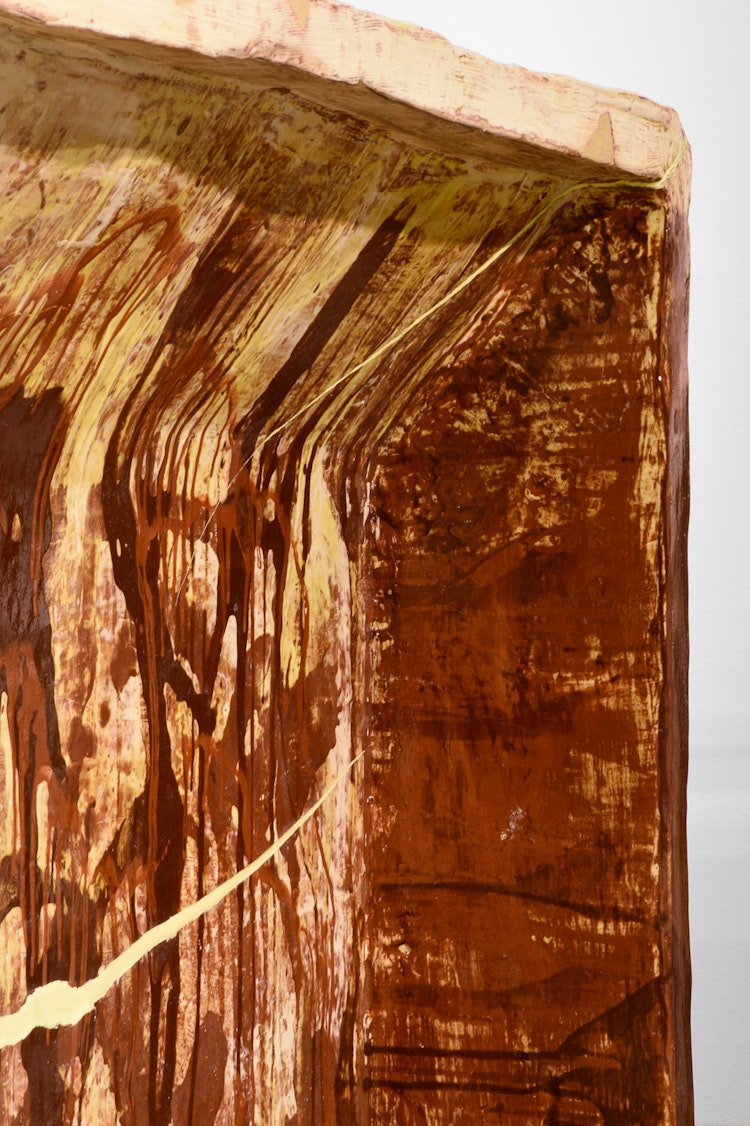
The discovery of this method, which now defines her idiom, came after ten years of fretting about her own work not being good enough. She recalls talking down her own skills, which she always considered inferior to those of her peers.
‘They were all better than me at either throwing or decorating – if not both.’
One day, when Tingleff felt dissatisfied with her own ability to make a seemingly simple decor that she observed in the work of her colleagues, she tried removing it by washing off the slip. It dawned on her that she would only overcome what she considered her lack of skill if she accepted it and embraced the very “clumsiness” of the earthenware medium as something to explore. This evolved into a ten-year open research project, during which time she had to face, ‘rejection upon rejection’ from the committees of important shows.
‘With the pieces where the slips had been washed off and applied in layers, I had made something the juries hadn’t seen before.’
A mantra of her own
By this point in her career she had at last put into practice something one of her teachers had tried to make her accept when she was still a student. That teacher was Eilif Amundsen (1930–2007), who taught classical painting with a focus on still-life and life classes. While his student, Tingleff was never satisfied with what she produced, lamenting that she was good at neither drawing nor painting.
‘He said to me, “Marit, you have to accept your own drawn line or you won’t move on.” And those words became my mantra and tune, and I went on accepting it, saying to myself, “That line on the paper, that’s my line – that’s how I draw.” It was an important lesson – because it makes it less relevant to pass judgement on what is good and what is not. Instead, the thing that matters is to make something with the materials and skills you actually have, to see the possibilities in what’s at hand,’ she says.
Summarising her path, Tingleff stresses that she is delighted by the struggle involved in finding the abilities she now uses – and consequently also by all the years of work in which ‘everything was really difficult and I had to innovate and develop techniques along the way’.
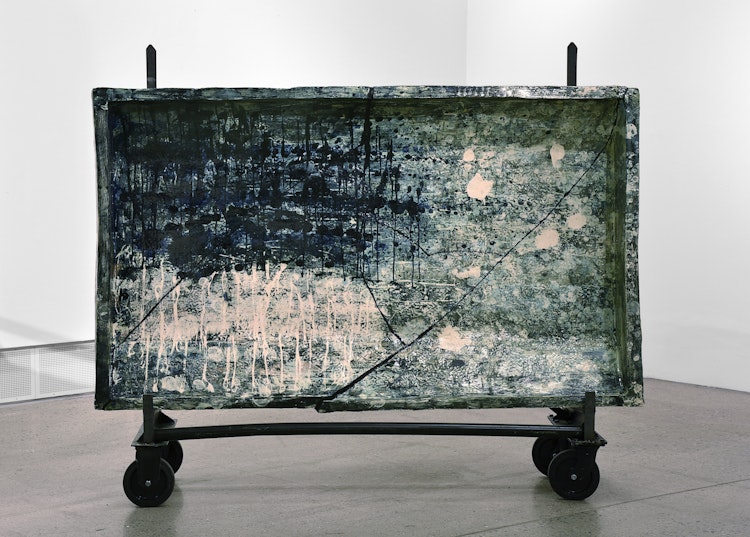
It is probably wrong to think of her work in terms of formulas, since that doesn’t quite do it justice; trial and error are vital to the process at every stage.
‘I sometimes make samples and prepare the process, but then I always end up taking a few chances once the process is underway. And doing something new and unprepared can easily boomerang and give very bad results. But it can also bring surprises. And for an artist, that is a massive bonus – when even your own expectations are surpassed by taking a risk along the way.’


